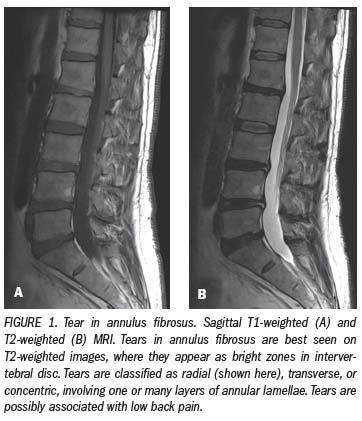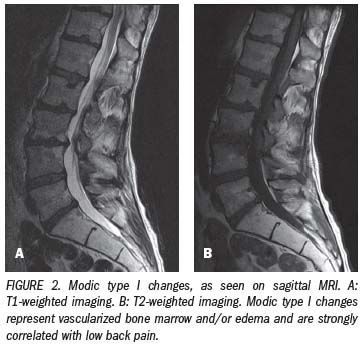Correct Application Of MRI: helps find causes of lower back pain
Low back pain is extremely common in Western society.1 It is second only to upper respiratory illness as a symptom-related reason for visits to the doctor.2
Low back pain is extremely common in Western society.1 It is second only to upper respiratory illness as a symptom-related reason for visits to the doctor.2
It is generally believed that most cases of low back pain are benign and self-limiting. The real challenge for the clinician is to distinguish serious spinal pathology from nonspecific low back pain.3 The patient’s history and the clinical, laboratory, and imaging findings may help in differentiating these causes. The history should include an assessment of psychosocial risk factors, which predict risk for chronic disabling back pain.4
The main role of imaging is to rule out serious pathology and/or to detect, localize, and target treatable causes. Disc herniations and degenerative disc disease are the most common treatable reasons for low back pain. Other reasons for imaging may include reassuring the patient and/or clinician, monitoring treatment, and following up a known pathology.
ACUTE PAIN
Low back pain is defined as acute during the first six to 12 weeks and chronic thereafter. Imaging is not typically recommended during an initial episode of acute low back pain in the absence of leg pain unless other specific findings are present. These additional “red flag” findings indicate the possibility of a serious underlying condition such as trauma, cauda equina syndrome, progressive neurologic deficit, infection, and/or malignancy.5,6
A detailed discussion of imaging in spinal trauma is beyond the scope of this article. In short, clinical findings and the patient’s history are generally used to determine whether imaging is needed, and whether the first-line tool should be plain-film radiography or CT. Minor trauma may cause compression fractures in patients who are elderly, have a history of osteoporosis, and/or take steroids.
Cauda equina syndrome is typically characterized by low back pain, sciatica, lower extremity sensorimotor loss, and bowel and/or bladder dysfunction. Full-blown cauda equina syndrome includes urinary retention, saddle paresthesia of the perineum, bilateral lower extremity pain, numbness, and weakness.7 The pathophysiology remains unclear, though damage to the nerve roots composing the cauda equina, from either direct mechanical compression or venous congestion and/or ischemia, may be a contributory cause.
Early diagnosis is often challenging because the initial signs and symptoms are frequently subtle.7 Given that the preferred treatment strategy is urgent surgical decompression of the spinal canal, imaging is a cornerstone in the workup of these patients. Frequent causes of cauda equina syndrome include disc herniation, trauma, and/or vertebral metastasis with secondary spinal stenosis and compression of the cauda equina. MRI is regarded as the modality of choice owing to the diversity of potential causes of compression and difficulty ascertaining the thoracolumbar level of compression.
Spinal infections can occur in the bone of the vertebral column, the intervertebral disc space, the spinal canal, or any combination of these. Only 0.01% of patients presenting with low back pain will have a spinal infection. These infections can cause significant levels of pain.
Imaging is warranted in patients with severe, progressive low back pain coupled with fever and a known history of intravenous drug use, and in cases of recent infection combined with positive inflammatory blood markers. A negative plain film cannot rule out the presence of spinal infection. MR imaging, consequently, is essential in these patients to confirm or exclude the diagnosis of infection.
Between 80% and 90% of cases of low back pain are referred to as aspecific because the anatomical origin remains elusive. Intervertebral discs, facet and sacroiliac joints, and, to a lesser degree, ligaments and muscles, can all play a role. It is usually impossible to assign acute low back pain to a structural or functional cause using patient history and/or clinical or imaging findings.
DISC PATHOLOGY
Intervertebral disc pathology is thought to be one of the causative factors of low back pain.8 Innervation to the intervertebral disc may account for instances of discogenic low back pain.9 Studies have shown that innervation of the inner disc is observed only in painful discs, not in normal discs.10,11 This suggests that nerve ingrowth into the inner disc may be a cause of nonspecific discogenic low back pain. MRI findings of painful discs are typical of those for disc degeneration. Signal loss on T2-weighted MRI is the most common finding, though imaging may also reveal a loss of disc height, the presence of a hyperintensity zone, and Modic changes (see below).12
The hyperintensity zone is a localized region of high signal intensity on T2-weighted MRI within the annulus fibrosus. The histopathology of these lesions represents replacement of the normal lamellar structure by a disorganized, vascularized granulation tissue, consisting of small round cells, fibroblasts, and newly formed blood vessels around tears extending from the nucleus pulposus to the outer region of the annulus fibrosus.13 The presence of a hyperintensity zone may or may not correlate with a painful disc on discography.14,15 The association between an annular tear on MR images and low back pain remains unclear (Figure 1).

Modic changes in the vertebral endplates adjoining a degenerative disc were first described in 1988.16 Two types of changes were reported. Type 1 corresponded histopathologically to vascular granulation tissue (Figure 2), while type 2 changes represented fatty degeneration. Type 3 changes were added later to represent bone sclerosis. Some groups also use the term Modic type 0 for normal vertebral bone marrow. Type 1 changes are dark on T1-weighted MRI and bright on T2-weighted images. Type 2 changes are bright on both sequences, while type 3 changes are dark on both sequences.

Modic type 2 changes are most common (60% to 90% of cases), followed by type 1 changes (10% to 40%). Type 3 changes are rare. The presence of Modic changes in asymptomatic patients is reported in up to 10% of cases. Modic type 1 changes are extremely uncommon in this group (<0.1%). The prevalence of Modic changes increases with age, and is seen in 20% to 60% of patients with low back pain. Modic changes are common in patients with nonspecific low back pain (median prevalence 43%) and less common in nonclinical populations (median prevalence 6%).17
It is not clear why Modic changes are associated with low back pain. It has been reported that lumbar vertebral endplates exhibiting Modic changes have elevated levels of tumor necrosis factor and more immunoreactive nerve cells and fibers. This is particularly true when type 1 changes are seen.18
CHRONIC PROBLEM
Many cases of chronic low back pain have a biomechanical cause, although the differential diagnosis is extensive. Imaging should be ordered only when absolutely necessary, given the high incidence of radiologic abnormalities in asymptomatic individuals.19 A medical history and physical examination are particularly important to distinguish potential causes and identify red flags for more serious conditions. Some conditions, such as sphincter or gait disturbance, will warrant a prompt MRI of the spine.
The spine is recognized as the most common site for bony metastases in patients with known malignancy. Metastases are found in 10% of patients with malignant neoplasms. Spinal metastases most often originate from carcinomas of the breast (21%), lung (14%), prostate (7.5%), kidney (5%), and gastrointestinal tract (5%).20 These tumors generally involve the bones of the vertebrae or the surface of the spinal cord. Fewer than 5% of all metastatic spine tumors are intradural (either intra- or extramedullary).
MRI is much better than plain-film radiography at detecting and ruling out vertebral metastases. It is also more accurate than radionuclide bone scanning. MRI is therefore advocated as a tool for screening patients with breast, lung, and prostate cancer who have a high risk of metastatic disease, in addition to PET.21 Other systemic diseases that may affect the spine include multiple myeloma, lymphoma, and leukemia.
LEG PAIN
Leg pain that follows a particular dermatome is also called radicular pain or sciatica. Pain that occurs in an aspecific region is classified as nonradicular pain.
Acute lumbar disc herniations are the most common cause of acute radicular leg pain. Emergent causes, such as cauda equina syndrome, epidural abscess, fracture, or malignancy, should be excluded first. Patients should then follow a six-week trial of conservative management and be advised to stay active.22 Imaging and invasive procedures may be considered if symptoms persist after six weeks or if neurologic function worsens.
Most patients with lumbar disc herniations improve over six weeks. Surgical discectomy may relieve symptoms more quickly than continued conservative management if a disc herniation identified on imaging correlates with physical findings. Epidural steroid injections can also provide short-term relief.22
It is easier to detect herniated discs with MRI than CT for a number of reasons. MRI can visualize the complete lumbar (or cervical or thoracic) spine in one examination. Sagittal MR images can also depict the spinal canal between intervertebral disc spaces. It is not unusual for a disc fragment to migrate (or extend) into the area behind the vertebral body. Some of these migrated discs can be missed on CT if only axial slices are used to examine the intervertebral disc spaces.
Another advantage of MRI is that it has intrinsically better tissue contrast than CT. The cervicothoracic and/or lumbosacral regions can be especially hard to assess on CT due to beam hardening, especially in larger patients.
Chronic radicular pain can be caused by a disc herniation, vertebral osteophytic spurs, and degenerative foraminal stenosis. Foraminal nerve root entrapment is best visualized on T1-weighted MRI, where the high contrast between fatty tissue and the nerve root sheath is a great help.
The anteroposterior diameter of the foramen is diminished by a combination of hypertrophic degenerative facets with osteophytic spurs posteriorly and vertebral osteophytes and/or disc herniation anteriorly. Foraminal height is lessened by degenerative disc disease and subsequent disc height loss. Nerve root compression should be considered whenever the normal rounded (oval) appearance of the nerve root sheath is lost in combination with a loss of surrounding fat tissue.
Nonradicular low back pain may arise from changes to the posterior elements/perispinal tissues of the lumbar spine, such as the posterior vertebral compartment.23 This includes facet joint pathology (e.g., osteoarthritis, joint effusion, synovitis, and synovial cysts) (Figure 3), spinal/perispinal degenerative/inflammatory ligamentous changes, and perispinal muscular changes.
MRI is the most sensitive modality for evaluating spinal degenerative pathology, even in the initial stages of disease. Fat-saturated T2-weighted sequences and, when indicated, contrast-enhanced T1-weighted MRI, also with fat saturation, are generally used. These sequences can visualize degenerative/inflammatory changes of the lumbar spine’s posterior elements that in most cases would be overlooked without fat suppression.
Pathology in the vertebral column, such as spondylosis, fractures, and/or vertebral metastases, are also a possible cause of nonradicular spinal pain.
In conclusion, imaging can play an important role in the workup of patients with low back pain. Imaging not only helps to exclude significant underlying pathology, but it is also essential in detecting and locating the cause of low back pain, which may be treatable.
GE HealthCare Debuts AI-Powered Cardiac CT Device at ACC Conference
April 1st 2025Featuring enhanced low-dose image quality with motion-free images, the Revolution Vibe CT system reportedly facilitates improved diagnostic clarity for patients with conditions ranging from in-stent restenosis to atrial fibrillation.
The Reading Room Podcast: Current Perspectives on the Updated Appropriate Use Criteria for Brain PET
March 18th 2025In a new podcast, Satoshi Minoshima, M.D., Ph.D., and James Williams, Ph.D., share their insights on the recently updated appropriate use criteria for amyloid PET and tau PET in patients with mild cognitive impairment.